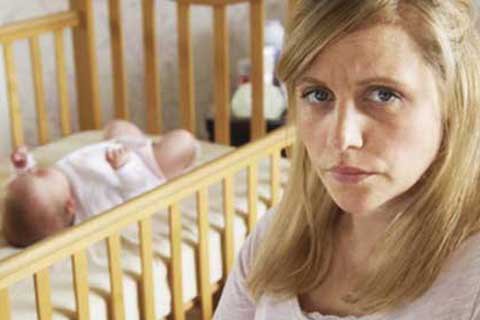Most women experience some form of postpartum mood disturbance following the birth of their child. For many, the symptoms are mild and disappear within two weeks. But a small percentage of mothers go on to develop depression, one or more postpartum mood disorders, or even psychosis. The good news is, with intervention women can recover.

Baby Blues
This was the case with Julie O’Neill. Shortly after her daughter was born, O’Neill began experiencing troubling symptoms. “It started in the hospital when I had problems with breastfeeding, and by the time I got home I was feeling all the pressures of new motherhood,” she says. “That first week I was very teary, but I chalked it up to baby blues and thought I’d be okay soon. By week two I found myself waking up shaking due to panic attacks. I wasn’t able to eat or sleep either. Having been a social worker, I was familiar with the symptoms of depression and knew I needed help.”
“Up to 80 percent of new mothers experience baby blues and have mild feelings of depression, but problems that persist beyond two weeks could be pointing to postpartum depression (PPD),” says Janet Brown, MSN, APRN, BC, perinatal behavioral health specialist. “And its appearance may be delayed for up to a year after giving birth.”
Katharine Weymouth, MD, LLC, a private practicing psychiatrist specializing in women’s mental health, agrees. “The symptoms go beyond fatigue, irritability and difficulty concentrating. That’s considered normal when caring for an infant,” she says. “Postpartum depression can include sadness, irritability, insomnia, fatigue, feelings of guilt or worthlessness, change in appetite or concentration, difficulty enjoying things and recurring thoughts of harming one’s self.”
In addition to postpartum depression, mothers may experience one or more of the four postpartum anxiety disorders or postpartum psychosis, a rare condition characterized by disorganized thinking, hallucinations and delusions. With any of these conditions early detection and intervention is key. “What many people don’t realize that is women are at risk for these conditions while pregnant as well,” says Weymouth. “I suggest they talk with their doctor before they conceive to avoid potential problems, particularly if they have a history of depression or anxiety.”By week’s end O’Neill had contacted her physician. But the doctor on call phoned in a prescription her insurance wouldn’t cover. “That Monday I took myself to the hospital and they referred me to their Perinatal Behavioral Health Department,” she says. “There I was diagnosed with postpartum depression and anxiety. They put me on medication with continued monitoring and recommended I join the support group offered through the hospital. Six weeks later I was feeling better.”
For Crystal Lohr, intervention wasn’t immediate and she suffered severely as a result. A week after giving birth to her daughter, this single mother started having nightmares that left her trembling in sweaty sobs. “A-year-and-a-half later I began having painful anxiety attacks that felt like someone was squeezing my rib cage and stabbing me in the heart. I didn’t want to interact with my daughter either. I would sit and watch her play, but instead of joining in I’d curl up in a ball and cry,” she says of her now 3-year-old. “I knew I needed help, but I thought I could take care of it myself. On top of that I was embarrassed and didn’t want anyone to know.”
Then, two-and-a-half years later while taking her daughter for a check up, Lohr broached the subject. “I told the doctor I knew I suffered from postpartum depression and now it had gotten worse. So she asked me, ‘On a scale from one to ten, how happy are you right now – ten being the happiest?’ I told her three then burst into tears,” she says.Lohr was diagnosed with anxiety and severe depression that stemmed from postpartum. “The doctor explained that it’s like a disease and needs to be treated. I started on Citalopram, and a week later I was feeling better,” she says.
Treatment options vary depending on the disorder and severity of symptoms. “Some women do fine with support groups. But others may need one-on-one therapy with a mental health professional to help develop new coping strategies,” says Brown. “Medication may also be administered where symptoms are significant.”
One thing O’Neill found particularly helpful were the support group meetings. “It was good to be with other moms who were feeling the same way. We connected through our struggles and drew strength from one another,” she says. O’Neill, in fact, continued to attend meetings even after she had recovered to encourage other moms and has since started a second support group which meets at a different location. More recently she joined the team of Postpartum Support International to work as an advocate for new mothers and their families. Today she’s on a mission: “I want to tell mothers that postpartum depression is treatable and you’re not alone. With the help of support groups, counseling and medication it will get better,” she says. “Now that I’m expecting again I have the tools to get through this, should it happen again.” +
POSTPARTUM MOOD CONDITIONS
The following is a list of postpartum mood conditions. Women with a personal or family history of mood disorders should talk with their physician prior to conceiving as they are at a higher risk of developing conditions while pregnant or postpartum. If any of these symptoms persist two weeks after delivery, women should get an evaluation by their physician or mental health professional.
BABY BLUES occur in up to 80 percent of new mothers due in part to hormonal changes postpartum. Symptoms, which include extreme tearfulness, irritability, anxiety, mood swings, feelings of inadequacy, insomnia and fatigue, can appear right after delivery, peak at five days and usually disappear by twelve days postpartum. A small percentage of women with baby blues go on to develop postpartum depression. Baby blues are the only one of these conditions considered a disturbance, not a disorder.
POSTPARTUM DEPRESSION occurs in up to 13 to 15 percent of women and is said to be the most common complication of childbearing. Symptoms parallel clinical depression and can include sadness, lack of interest in things particularly bonding with the baby, feelings of guilt or inadequacy, worthlessness, irritability, impatience, sense of hopelessness, insomnia, change in appetite or concentration, difficulty enjoying things and recurring harmful or suicidal thoughts. Symptoms can occur soon after delivery or up to a year postpartum.
POSTPARTUM ANXIETY DISORDERS, which include anxiety, panic, obsessive-compulsive (OCD) and post-traumatic stress (PTSD), occur in up to ten percent of women suffering with postpartum depression. Symptoms vary according to disorder and may come and go, but one common characteristic they share is excessive worry that interferes with one’s ability to function. Here is a breakdown:
- Postpartum anxiety disorder symptoms could include feeling keyed up, tiring easily, irritability, fidgety, insomnia and difficulty focusing.
- Postpartum panic disorder is characterized by sweating, trembling, nausea, dizziness, difficulty breathing, tight chest and numbness in hands and feet.
- Postpartum obsessive-compulsive disorder symptoms include repetitive behaviors or thoughts which cause anxiety, worry or panic. It may also be accompanied by protective behaviors and constant, obtrusive thoughts related to the baby’s safety. Note this is not postpartum psychosis. Women with OCD have no intent of harming their child. These thoughts are very disturbing to them and because they don’t understand it, the condition is accompanied by fear, shame and emotional turmoil. This is, in fact, the one disorder people know the least about and most women are afraid to talk about for fear others will think they are crazy.
- Postpartum traumatic stress disorder occurs in women who experienced trauma during pregnancy, labor and/or delivery. Symptoms, which can occur up to two months after deliver, can include flashbacks about what happened, nightmares and hyper vigilance.
POSTPARTUM PSYCHOSIS is a rare disorder that occurs in only one to two percent of women who deliver. Symptoms usually develop within 48 to 72 hours postpartum and can include delusions, hallucinations, disorganized speech and inappropriate behavior. Symptoms may also be preceded by a period of restlessness or agitation. Women with a history of bipolar disorder are at a higher risk for developing postpartum psychosis, and in-patient psychiatric treatment and medication may be required immediately.
RESOURCES:
Postpartum Support International (PSI) is an organization dedicated to providing information, resources and support on postpartum issues. For more information, log onto www.postpartum.net , or call 800-944-4PPD (4773).
www.MedEdPPD.org was developed by the National Institute for Mental Health (NIMH) to provide information about postpartum depression.
www.womensmentalhealth.org is an online resource created by Massachusetts General Hospital as a way to provide up-to-date information and resources on women’s mental health issues.
Denise Yearian is the former editor of two parenting magazines and the mother of three grown children.
Tags
Views: 2






